Note: In polite company or in public arenas or in schools and conferences, what have you, what is it to be anti-semitic according to the Israel Occupation Forces legions of facilitators like the ADL, AIPAC, and a list of tens of thousands of Jewish controlled non-profits and foundations?
Pro-Israeli circles often try to invent an anti-Semitic element behind every legitimate criticism of Israel.
But this is a cheap and increasingly exposed exploitation and manipulation of true anti-Semitism a morbid form of racism that ought to be denounced.
However the behaviors of the shipyard dogs of Zionism would have us believe that true anti-Semites are no longer those who hate Jews for being Jewish but rather those Zionist fanatics criticize for criticizing Israel for being criminal murderous and evil.
Well we are supposed to be living in a moral universe where no people should have more rights than the rest of mankind.
Proceeding from this timeless basic logic if criticizing Israel including questioning the moral legitimacy of Israel’s very existence amounts to anti-Semitism then humanity has a moral obligation to be anti-Semitic.
Opponents of Israel it must be proclaimed loudly don’t hate Israel because Israel is Jewish; they hate Israel because Israel happens to be a gigantic crime against humanity a virulent practitioner of ethnic cleansing and apartheid which is committed to the national destruction of another people the Palestinian people.
Yes anti-Judaism is wrong and should be rejected. However if Judaism especially Jewishness can not maintain a decent and peaceful existence outside the realm of racism apartheid and genocidal supremacy then people will have second thoughts about Judaism. — effing 2012 Op-Ed, The absurdity of equating opposition to Israel with anti-Semitism
No lover of ANY POTUS, especially Truman, but, that broken white psychosis can get it right once in a blue moon:
In 1948 President Harry Truman was infuriated by Jewish terrorism which was nothing in comparison to Israel’s terror these days angrily wrote in a letter to Eleanor Roosevelt: “I fear very much that the Jews are being like all underdogs. When they get on top they are just as intolerant and cruel as the people were to them when they were underneath.” (Eleanor and Harry: The Correspondence of Eleanor Roosevelt and Harry S. Truman Eleanor Roosevelt, [Scribner/Drew, 2002] p.187.)
No fan of Stanley, as he calls the American University the most Jewish of institutions; however,
Jason Stanley, a philosophy professor who recently decided to leave Yale to go teach in Canada, recently explained on PBS’ Amanpour & Company why he thinks the Trump administration’s efforts are actually boosting antisemitic tropes:
This is reinforcing antisemitic tropes all across the political spectrum. … What are the most toxic antisemitic tropes? Well, “Jews control the institutions.” This is absolutely reinforcing this. Any young American is going to think: Remember what happened when they took down the world’s greatest university system on behalf of Jewish safety? And this will go down in history books — the history of this era will say that Jewish people were the sledgehammer for fascism. So if we don’t speak out, if we American Jews do not speak out against this, this will be a grim chapter in our history as Americans. It’s the first time in my life as an American that I have been fearful of our status as equal Americans — not because of the protests on campus, which, as I said, had a lot of Jewish students in them. But because we are suddenly at the center of U.S. politics. It’s never good to be in the crosshairs for us. And we are being used to destroy democracy.
So, this following little doozy would be put on the targets for IOF and others loving the Jewish Raping Murdering Starving Displacing Poisoning Polluting Occupied State of “Israel”/Palestine.
Over an effing billion of these Goy-ionists?
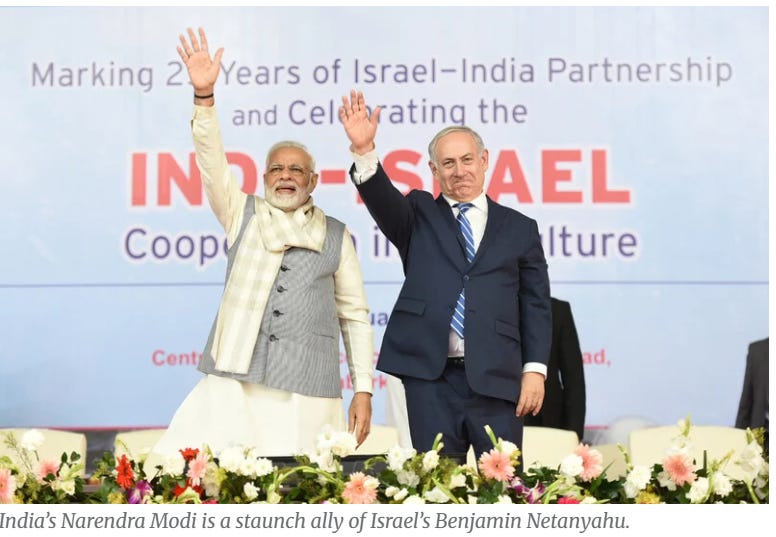
Days later, India launched Operation Sindoor, a wave of air strikes, describing them as “non-escalatory” in nature. Yes, that is the face of Judaism in that part of the world, where Benzion Mileikowsky works wonders on the Jewish Population where 84 percent plus want all Palestinians wiped from lower Greater Israel.
Many of the drones used in the operation were Israeli-made.

Among the systems deployed was the Harop, a “suicide drone” developed by Israel Aerospace Industries (IAI). Designed to hover above a target area before diving for impact, the Harop carries a 10-kilogram warhead and can remain airborne for nearly six hours.
Since acquiring the Harop, India has increasingly relied on it.
Oshrit Birvadker, a fellow at the Jerusalem Institute for Strategy and Security, told The Times of Israel that India’s use of Harop drones reflects “Israel’s growing footprint in Indian defense.”

That’s fourth globally in arms sales, Jewish State of Murdering Maiming Raping Starving Poisoning Polluting Displacing Israel (sic).
Marching to get into the Katz’s and Benzion Mileikowsky’s heads? For fuck’s sake!
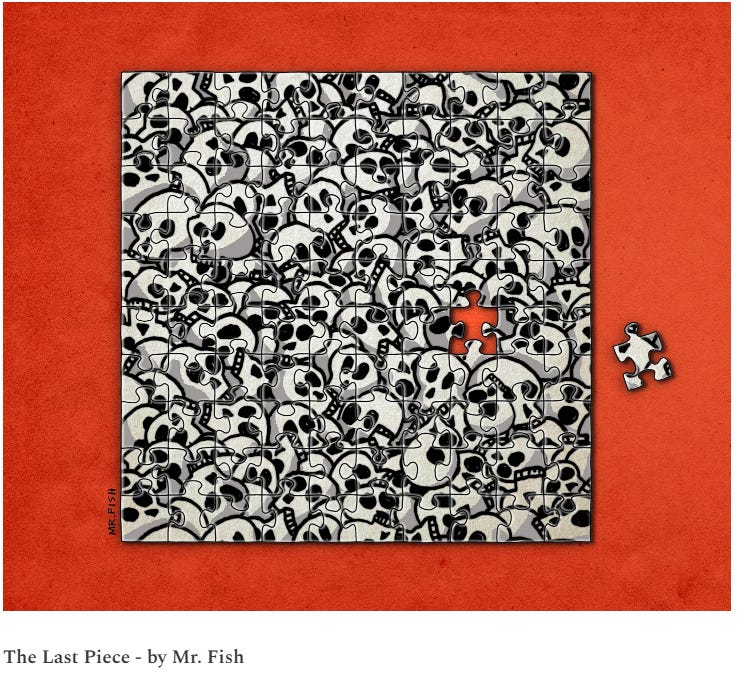
Chris Hedges: This is the end. The final blood-soaked chapter of the genocide. It will be over soon. Weeks. At most. Two million people are camped out amongst the rubble or in the open air. Dozens are killed and wounded daily from Israeli shells, missiles, drones, bombs and bullets. They lack clean water, medicine and food. They have reached a point of collapse. Sick. Injured. Terrified. Humiliated. Abandoned. Destitute. Starving. Hopeless.
In the last pages of this horror story, Israel is sadistically baiting starving Palestinians with promises of food, luring them to the narrow and congested nine-mile ribbon of land that borders Egypt. Israel and its cynically named Gaza Humanitarian Foundation (GHF), allegedly funded by Israel’s Ministry of Defense and the Mossad, is weaponizing starvation. It is enticing Palestinians to southern Gaza the way the Nazis enticed starving Jews in the Warsaw Ghetto to board trains to the death camps. The goal is not to feed the Palestinians. No one seriously argues there is enough food or aid hubs. The goal is to cram Palestinians into heavily guarded compounds and deport them.
Some bulwarks across international community would stop this. Fuck, it is a Jewish project across all DNA-lines.
Given Britain’s continued support for Israel, from refusing to implement a full arms embargo to continuing to send RAF spy flights over Gaza from the British base at RAF Akrotiri in Cyprus, Ahmed questions whether efforts have indeed been enough.
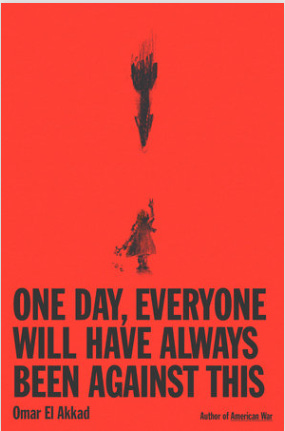
Israeli drones sprayed the Madleen with a white substance and an Israeli boat rammed the aid vessel before commandos boarded it, all because it contained things like baby food, medicine and prosthetics. Israel must defend itself from those things, apparently.

Is this a certain brand of Jewish Inspired, Supported, Financed death and murder cult? Is the question antisemitic?

Dirty dirty Sweden:

The Temporary Protection Directive (2001/55/EC) (commonly referred to as collective temporary protection) was activated in March 2022, granting Ukrainians seeking refuge temporary protection in EU countries, including Sweden. This directive provides residence permits, access to work, education, and limited social benefits without requiring individuals to go through the standard asylum process.
However, the practicalities of the Directive’s use differed significantly between countries. Sweden, despite its, until recent, reputation of being relatively liberal in its migration policies, has at times, lagged behind its Scandinavian neighbors in supporting Ukrainian displaced people. To illustrate this, it is useful to compare the Swedish approach to that of other Nordic states, as well as Poland.
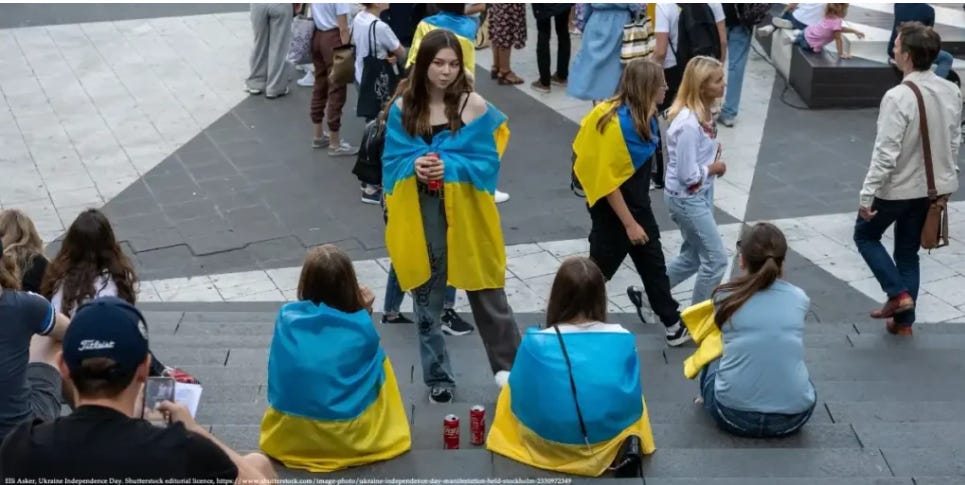
Bizarrely, Israel’s act of piracy was described by the BBC as “diverting” the Madleen. In what universe was this a diversion? When you capture people in international waters who have committed no crime, you have not diverted them, you have kidnapped them. The crew of the Madleen are hostages, and not only that, Israel is already bragging about how it plans to abuse them.
The crew of 12, who the media describe as “activists”, comprised of journalists, politicians, and a doctor. They are to be taken to the port of Ashdod where they will be psychologically tortured by the IDF/IOF.
Israel Katz says he has given the order to make the crew watch footage of October 7th to show them “exactly who the terrorist organization they came to support and for whom they work is”. Presumably, they will only watch the killings carried out by Hamas and not the enactment of the Hannibal Directive killing hundreds of Jews by Jews.

Pointing out the non-Jews and Jews involved, is that antisemitic?
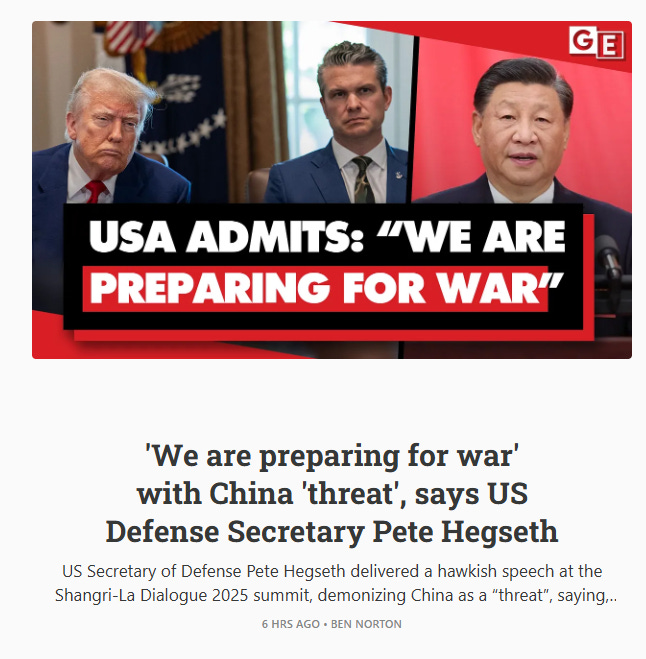
Remember this Jewish guy?
1992 document published by the US Department of Defense, known as the Wolfowitz Doctrine (because it was co-written by Paul Wolfowitz, who then served as US undersecretary of defense for policy, before later returning as Secretary of Defense under George W. Bush).
The Pentagon’s Wolfowitz Doctrine stated (emphasis added):
Our first objective is to prevent the re-emergence of a new rival. This is a dominant consideration underlying the new regional defense strategy and requires that we endeavor to prevent any hostile power from dominating a region whose resources would, under consolidated control, be sufficient to generate global power. These regions include Western Europe, East Asia, the territory of the former Soviet Union, and Southwest Asia.
The Trump administration’s foreign policy is still consistent with much of the Wolfowitz Doctrine. Although Trump has de-prioritized Western Europe and the territory of the former USSR, he has dedicated significant resources to US military operations in East Asia and Southwest Asia (also known as the Middle East).

Yep, even CIA-drenched Wikipedia advances Ratner’s Judaism:
Ely Ratner, who served as the assistant secretary of defense for Indo-Pacific security affairs in Biden’s Pentagon, wrote approvingly on X/Twitter, “Rhetoric aside, on actual defense policy Secretary Hegseth’s speech was near total continuity with the previous administration”.
“That’s good, but we’ll need heightened urgency, attention, and resources to address the China challenge”, Ratner added.
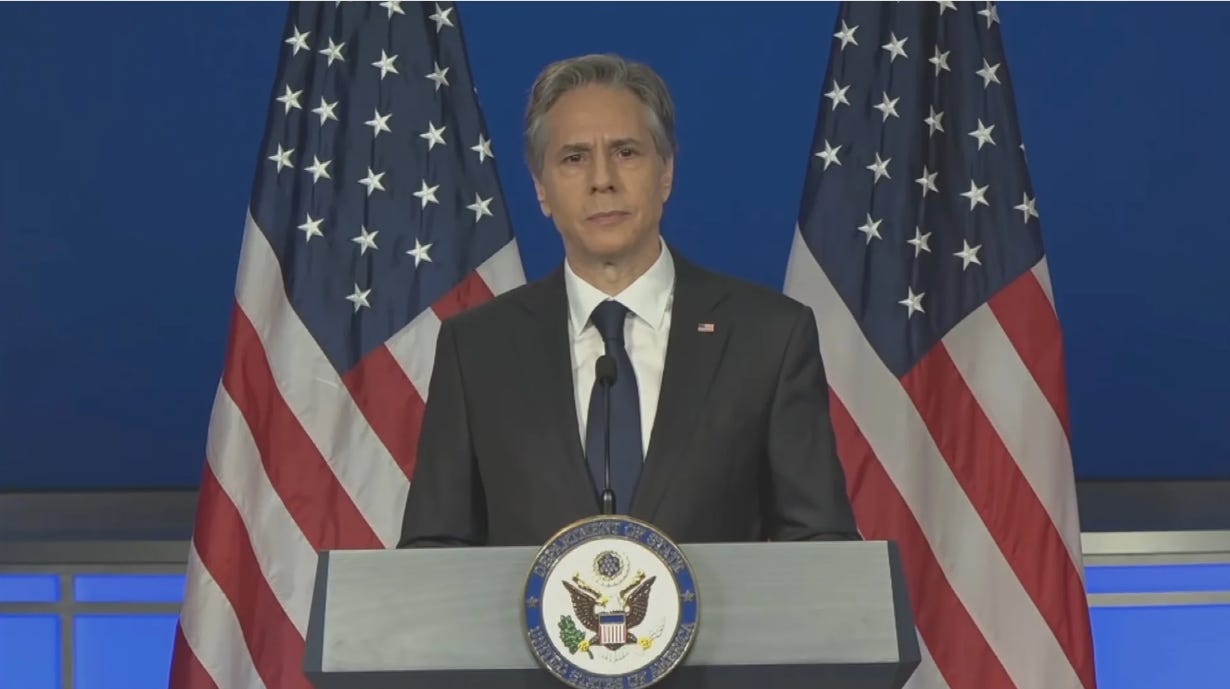
This fellow for years advanced his Jewishness for sure Zyklon or Final Solution Blinken:
Biden’s neoconservative Secretary of State Antony Blinken had also maintained a hardline anti-China position.
In a speech in 2022, Blinken announced what was essentially a containment policy targeting China.
“We cannot rely on Beijing to change its trajectory. So we will shape the strategic environment around Beijing”, he said.
Blinken added, “The scale and the scope of the challenge posed by the People’s Republic of China will test American diplomacy like nothing we’ve seen before”.
Tucker Carlson has posted an extraordinary article on X that could potentially stop a war with Iran. As everyone knows, Carlson’s political views are admired by President Donald Trump who sees the former Fox commentator as a blunt, but fair-minded analyst who sees the world in similar terms as himself. And while there’s no evidence that the two men communicate regularly, a number of pundits believe that Carlson has influenced Trump’s thinking, particularly on matters related to foreign policy. That said, it is entirely possible that Trump will read Carlson’s June 4 post on Iran, and see that—once again—influential neocons are making every effort to drag the US into another bloody conflict in the Middle East to achieve Israel’s ambition of becoming the preeminent power in the region. Here’s Carlson:
Mark Levin was at the White House today, lobbying for war with Iran. To be clear, Levin has no plans to fight in this or any other war. He’s demanding that American troops do it. We need to stop Iran from building nuclear weapons, he and like-minded ideologues in Washington are now arguing. They’re just weeks away.
If this sounds familiar, it’s because the same people have been making the same claim since at least the 1990s. It’s a lie. In fact, there is zero credible intelligence that suggests Iran is anywhere near building a bomb or has plans to. None. Anyone who claims otherwise is ignorant or dishonest. If the US government knew Iran was weeks from possessing a nuclear weapon, we’d be at war already.
Iran knows this, which is why they aren’t building one. Iran also knows it’s unwise to give up its weapons program entirely. Muammar Gaddafi tried that and wound up sodomized with a bayonet. As soon as Gaddafi disarmed, NATO killed him. Iran’s leaders saw that happen. They learned the obvious lesson.
So why is Mark Levin once again hyperventilating about weapons of mass destruction? To distract you from the real goal, which is regime change — young Americans heading back to the Middle East to topple yet another government. Virtually no one will say this out loud. America’s record of overthrowing foreign leaders is so embarrassingly counterproductive that regime change has become a synonym for disaster. Officially, no one supports it. So instead of telling the truth about their motives, they manufacture hysteria: “A country like Iran can never have the bomb! They’ll nuke Los Angeles! We have to act now!” Tucker Carlson (tuckercarlsonliveshowpodcast)
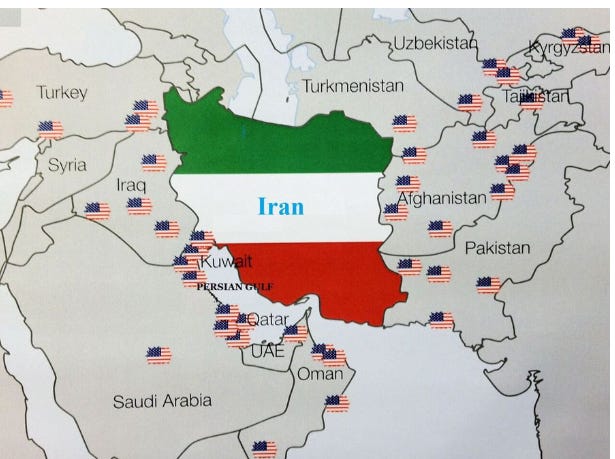
*****
Back to the death spiral of the Jewish Controlled Palestine:
In his book One Day, Everyone Will Have Always Been Against This, Omar El Akkad writes:
Should a drone vaporize some nameless soul on the other side of the planet, who among us wants to make a fuss? What if it turns out they were a terrorist? What if the default accusation proves true, and we by implication be labeled terrorist sympathizers, ostracized, yelled at? It is generally the case that people are most zealously motivated by the worst plausible thing that could happen to them. For some, the worst plausible thing might be the ending of their bloodline in a missile strike. Their entire lives turned to rubble and all of it preemptively justified in the name of fighting terrorists who are terrorists by default on account of having been killed. For others, the worst plausible thing is being yelled at.
You can see his interview with El Akkad here.
You cannot decimate a people, carry out saturation bombing over 20 months to obliterate their homes, villages and cities, massacre tens of thousands of innocent people, set up a siege to ensure mass starvation, drive them from land where they have lived for centuries and not expect blowback. The genocide will end. The response to the reign of state terror will begin. If you think it won’t you know nothing about human nature or history. The killing of two Israeli diplomats in Washington and the attack against supporters of Israel at a protest in Boulder, Colorado, are only the start.
Chaim Engel, who took part in the uprising at the Nazis’ Sobibor death camp in Poland, described how, armed with a knife, he attacked a guard in the camp.
“It’s not a decision,” Engel explained years later. “You just react, instinctively you react to that, and I figured, ‘Let us to do, and go and do it.’ And I went. I went with the man in the office and we killed this German. With every jab, I said, ‘That is for my father, for my mother, for all these people, all the Jews you killed.’”
Does anyone expect Palestinians to act differently? How are they to react when Europe and the United States, who hold themselves up as the vanguards of civilization, backed a genocide that butchered their parents, their children, their communities, occupied their land and blasted their cities and homes into rubble? How can they not hate those who did this to them?
What message has this genocide imparted not only to Palestinians, but to all in the Global South?
It is unequivocal. You do not matter. Humanitarian law does not apply to you. We do not care about your suffering, the murder of your children. You are vermin. You are worthless. You deserve to be killed, starved and dispossessed. You should be erased from the face of the earth.
“To preserve the values of the civilized world, it is necessary to set fire to a library,” El Akkad writes:
To blow up a mosque. To incinerate olive trees. To dress up in the lingerie of women who fled and then take pictures. To level universities. To loot jewelry, art, food. Banks. To arrest children for picking vegetables. To shoot children for throwing stones. To parade the captured in their underwear. To break a man’s teeth and shove a toilet brush in his mouth. To let combat dogs loose on a man with Down syndrome and then leave him to die. Otherwise, the uncivilized world might win.
There are people I have known for years who I will never speak to again. They know what is happening. Who does not know? They will not risk alienating their colleagues, being smeared as an antisemite, jeopardizing their status, being reprimanded or losing their jobs. They do not risk death, the way Palestinians do. They risk tarnishing the pathetic monuments of status and wealth they spent their lives constructing. Idols. They bow down before these idols. They worship these idols. They are enslaved by them.
At the feet of these idols lie tens of thousands of murdered Palestinians.
This post was originally published on Dissident Voice.
Security concerns involving the People’s Republic of China, and worries over the strategic direction of the Trump administration, may serve to deepen electronic warfare collaboration in Asia-Pacific. “In the Asia-Pacific region, there is no collective security organisation like that in Europe,” wrote Lieutenant General (Retired) Jun Nagashima, a senior research advisor at the Nakasone Peace […]
The post Share and Share Alike appeared first on Asian Military Review.
This post was originally published on Asian Military Review.
For defense and intelligence agencies operating in today’s high-speed global environment, timely geospatial intelligence is mission critical. Yet legacy systems are too slow. Delayed intel hurts everyone — defense ministries securing borders, civilian teams responding to disasters or agencies operating at scale. Outdated solutions make intelligence hard to request, unreliable in delivery and ultimately impossible […]
The post At your command: On-Demand intelligence from BlackSky appeared first on Asian Military Review.
This post was originally published on Asian Military Review.
Since the partition from India in 1947, Pakistan has been engaged in around a dozen significant and minor conflicts with India. Wars and negotiations are carried out based on the interests and directives of the respective central governments. Both Indian and Pakistani citizens are worried about a full-scale conflict, and the wounds of numerous wars are deeply felt at the local level. Recently, the population has been traumatized by Operation Sindoor and its subsequent retaliation. This research aims to promote peace by placing the people at the forefront, educating them about peace, and exerting pressure from the grassroots level up to the provincial and national levels to restore peace, unity, coexistence, security, and prosperity. The objectives are to promote positive peace between the two nations by empowering local people, fostering connections between them, and sharing the findings with interested parties.
The post India-Pakistan Escalation Of Conflict: Promoting Positive Peace appeared first on PopularResistance.Org.
This post was originally published on PopularResistance.Org.
The workers of the Samsung India’s Chennai plant secured a landmark wage revision agreement after a long battle with the company management on Monday, May 19. Samsung management was forced to agree to revise the wages of all workers at the plant, increase leave, and improve the overall working conditions at the factory.
The agreement was negotiated by the newly formed Samsung India Workers Union (SIWU) with the company management, under the mediation of the Tamil Nadu state government, where the plant is situated.
Announcing the agreement, A. Soundararajan, president of the Tamil Nadu Center for Indian Trade Union (CITU), with which the SIWU is affiliated, congratulated the workers and the SIWU leadership for the victory.
The post Workers In Samsung India’s Chennai Plant Win A Significant Pay Raise appeared first on PopularResistance.Org.
This post was originally published on PopularResistance.Org.
On Sunday 18 May, British bulldozer manufacturer JCB was due to celebrate its 80th anniversary at its headquarters in Rocester in the British midlands with a so-called ‘sportive’, a cycle ride which aimed to raise money for the children’s charity NSPCC. However, the sportive did not go according to plan thanks to people highlighting JBC complicity with Israel.
Activists from the Stop JCB Demolitions Campaign disrupted the event. They turned it into an expose of JCB’s complicity in ethnic cleansing and genocide. On top of this, they shamed NSPCC for accepting funds from a company which has destroyed children’s lives in Palestine, India, and Kashmir, plunging them into homelessness, poverty, and lasting trauma.
The company is notorious for profiting from the destruction of homes in all three locations.
JCB’s bulldozer genocide exposed at 80th anniversary event
Despite strict security, the activists managed to enter the sportive. When the JCB event began with the cyclists being flagged off, several cyclists revealed striking black and yellow T-shirts with the message: “Stop Bulldozer genocide In Palestine, India and Kashmir”:
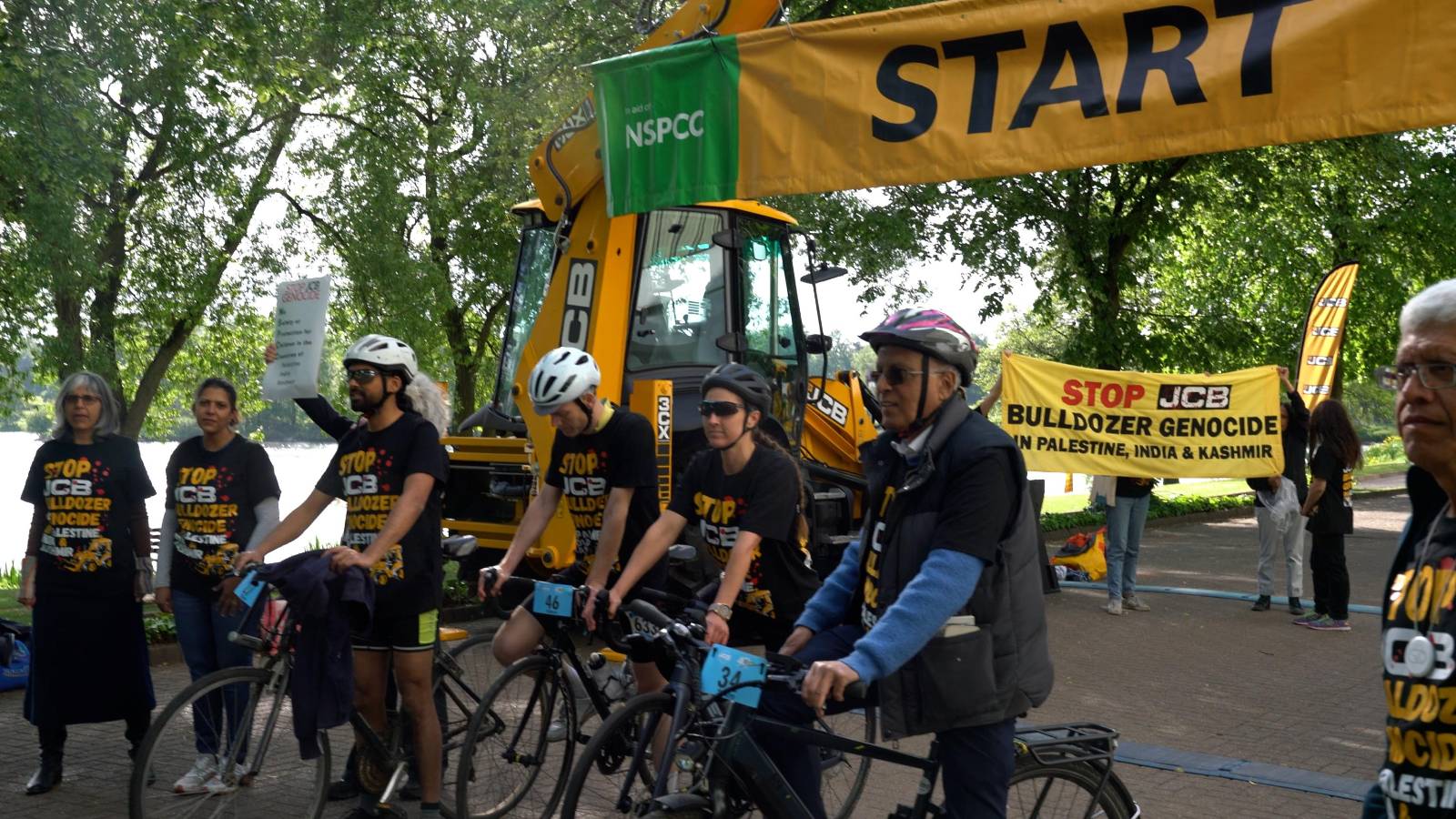
Simultaneously, supporters of the campaign shouted slogans and held banners accusing JCB of complicity in genocide. They also accused the NSPCC of a callous and racist lack of care for children in Palestine, India, and Kashmir:
#StopJCB
On JCB’s 80th anniversary event, their crimes in #Palestine, #India and #Kashmir were exposed!
JCB you can’t hide! Bulldozing homes is genocide! pic.twitter.com/82AtZP0cBm— SouthAsia Solidarity (@SAsiaSolidarity) May 18, 2025
Despite the JCB security guards best efforts, activists enacted this scene over and over again across the 50km route of the sportive.
JCB’s chairman, billionaire Anthony Bamford, or Baron Bamford of Daylesford and Wooton is a ‘super donor’ to the British Conservative party and a close friend of Boris Johnson. The Bamford family trusts control the JCB empire. It has been involved in offshore tax scandals.
More recently, Bamford has been aligning himself closer to the far-right Reform party. In March this year, party leader Nigel Farage entered a major Reform rally on a JCB machine that Bamford lent to him. Earlier, Bamford had treated him to a £8,000 helicopter flight to tour a JCB site.
So why is the NSPCC, the children’s charity whose aim is the “prevention of cruelty to children” accepting funds from a company which is complicit in ethnic cleansing in Palestine, India, and Kashmir?
NSPCC: taking funds from a company wrapped up in children’s rights abuses
Over the years, the NSPCC has been frequently asked to stop taking funds from JCB. Groups have provided it with evidence of the callous home demolitions JCB has carried out. As the UK Palestine Mental Health network has put it previously:
It would appear that children’s services provided by the NSPCC in the UK are financed in part by profits from state crime and the abuse and traumatisation of children overseas.
In India, state governments controlled by Narendra Modi’s Hindu supremacist Bharatiya Janata Party (BJP) have consistently used JCB bulldozers to demolish Muslim homes, shops, and places of worship. It’s part of an ongoing project disturbingly named ‘bulldozer justice’. In fact, JCB is so closely intertwined with this project that it has come to symbolise attacks on Muslims. All the while, the harm to children is incalculable.
For example, on the 2 February 2024, the demolition of a madrasa and 600 year-old Mosque in Mehrauli, South Delhi, left more than 20 orphaned children who lived in it displaced and traumatised. Authorities gave no notice before moving in the JCB bulldozers.
In Kashmir, in the name of development drives, authorities have demolished houses using JCB bulldozers across large areas. This has affected whole communities, and of course numerous children, permanently damaging their physical and mental health
JCB complicity with Israel: ‘hypocritically posing as family friendly’
The Stop JCB Demolitions Campaign is a coalition of organisations based in the UK. Two of its members – South Asia Solidarity Group and Nijjormanush – previously produced a report titled Stop JCB’s Bulldozer Genocide: A report on human rights violations in Palestine, India & Kashmir. This references a large number of cases where JCB has been involved in serious human rights violations.
The campaign has also filed a complaint with the UK National Contact Point. This is a government body promoting OECD guidelines on responsible business conduct. The complaint alleges that the manufacturer had failed to address the adverse human rights impacts from the use of its products in India.
The Stop JCB’s Demolitions Campaign has two main demands. Firstly, it demands that JCB must end its relationship with the Israeli Ministry of Defence. It states that it must cease all activities in occupied Palestine.
Secondly, it calls on it to commit to ensuring that its products are not used for human rights violations in India and Kashmir. Specifically, it suggests it should do this through robust monitoring and prevention systems. This includes making compulsory the use of its existing LiveLink technology to trace and locate JCB machines. It argues that JCB’s failure to use this technology is a deliberate violation of its human rights responsibilities.
Stop JCB Demolitions campaign member Mukti Shah said:
The fact that JCB continues to operate on behalf of the Israeli state in ethnically cleansing Palestinians in the Occupied Palestinian Territories and that they have also failed to make use of the technology they already have to prevent horrific human rights violations in India and Kashmir, despite an Indian Supreme Court ruling is utterly shameful
Josh – a cyclist who took part in the sportive – added:
I am glad to be here exposing the crimes of JCB, a British company which hypocritically poses as family friendly when in fact it is destroying communities in Palestine, India and Kashmir. As for the NSPCC, the fact that they are accepting JCB’s blood-stained money shows that they think only some children matter. This is blatant colonial racism.
Featured image and additional images supplied
By The Canary
This post was originally published on Canary.
This post was originally published on American Jewish World Service – AJWS.
India on Wednesday rejected China’s renaming of 27 places in Arunachal Pradesh as a “vain and preposterous” move, saying its northeastern border state, which Beijing claims is part of Zangnan or southern Tibet, remains an “integral and inalienable” part of the country.
On Sunday, China’s Ministry of Civil Affairs released its fifth batch of “standardized” names for over 27 places in Arunachal Pradesh – including mountains, mountain passes, rivers, residential areas, and a lake – in its latest attempt to bolster its claim over the territory that Beijing claims is Chinese territory and part of historical Tibet.
“We have noticed that China has persisted with its vain and preposterous attempts to name places in the Indian state of Arunachal Pradesh,” India’s Ministry of External Affairs spokesperson Randhir Jaiswal said in a statement.
“Consistent with our principled position, we reject such attempts categorically. Creative naming will not alter the undeniable reality that Arunachal Pradesh was, is, and will always remain an integral and inalienable part of India,” Jaiswal added.
China’s latest move to rename places in the Indian border state comes despite recent attempts by both nations to improve diplomatic ties, after Indian Prime Minister Narendra Modi met with Chinese President Xi Jinping in Russia last October shortly after their governments reached an agreement over a disputed area along their shared border.
That came after prolonged tensions, when thousands of Indian and Chinese troops faced off in June 2020 at three or four locations in the western Himalayas. India accused Beijing’s forces of intruding into Indian territory, although China denied it.
The two countries fought a border war in 1962, and China has mounted a long-standing campaign to assert its claim over areas held by India.
In 2017, China released its first list of standardized names for six places. Thereafter, it has carried out three more such renaming attempts, with new names for 15 places released in 2021, for 11 places in 2023, and 30 places in 2024.
In response to India’s condemnation of China’s latest move, the Chinese foreign ministry spokesperson Lin Jian said the Chinese government’s efforts to “standardize” the names of certain places in the region “is fully within China’s sovereignty.”
“The Zangnan region belongs to China,” Lin said at a press briefing on Wednesday.
India and China have made competing claims on territory along the disputed 1,130-kilometer (700-mile) border, known as the McMahon Line, between Tibet and the Indian state of Arunachal Pradesh.
India recognizes the McMahon Line, a boundary line drawn between Tibet and British India as agreed during the Simla Convention in 1914, as the international border. China, on the other hand, maintains that the boundary with India has never been delimited and claims areas south of the McMahon Line in Arunachal Pradesh as southern Tibet.

Sriparna Pathak, professor of China studies at the O.P. Jindal Global University in Haryana, India, and a former consultant at India’s foreign ministry, characterized China’s effort to change names as “cartographic aggression” – an attempt to boost its claims and normalize its occupation of regions it claims as its own.
Kalpit Mankikar, fellow for China Studies at the New Delhi, India-based Observer Research Foundation, highlighted China’s recent attempts to push its allies to use “Xizang,” instead of Tibet, to refer to the formerly independent country it annexed in 1950.
He said it is another example of Beijing’s strategy to rename places and ensure their consistent usage to erase Tibetan identity and further its narrative that Tibet has always been a part of China.
“This has been the fifth time that China has renamed places in Arunachal. And this is also part of the larger scheme of things, where it calls Tibet ‘Xizang’… so this is a long, long-drawn strategy,” Manikar said.
Edited by Mat Pennington.
This content originally appeared on Radio Free Asia and was authored by Tenzin Pema for RFA.
This post was originally published on Radio Free.
A group of Indigenous people who authorities evicted from their ancestral village in Nagarhole Tiger Reserve in south India 40 years ago, have returned to their former homes. The 52 Jenu Kuruba families faced down 130 police and forest guards to do so on Tuesday 6 May. And, on Wednesday, they declared they are there to stay permanently.
The community has begun to build new houses to replace the ones they were forced to leave 40 years ago. A small group of police and forest guards remain at the site.
Jenu Kuruba: Indigenous people return to their ancestral homes in Nagarhole
Their return on Tuesday was an act of tremendous courage, as forest guards had previously shot some Jenu Kuruba. More than 50 Jenu Kuruba families took part in the long-planned operation. Some carried pictures of loved ones who had died since the community’s expulsion from the forest.
Shivu, a young Jenu Kuruba leader, said:
We have today returned to our homelands and forests. We will remain here. Our sacred spirits are with us.
It’s believed to be the first time Indigenous people in India have asserted their rights in this way, to return en masse to their homes after they were evicted from a Protected Area.
Shivu added:
Historical injustice continues to happen over us by denying our rights on our lands, forests and access to sacred spaces. Tiger conservation is a scheme of the forest department and various wildlife NGOs to grab indigenous lands by forcefully moving us out.
When Forest Department officials and police confronted the Jenu Kuruba and warned them against re-occupying their homes on Tuesday, the Indigenous people castigated them for delays in recognizing their forest rights – and then went ahead:
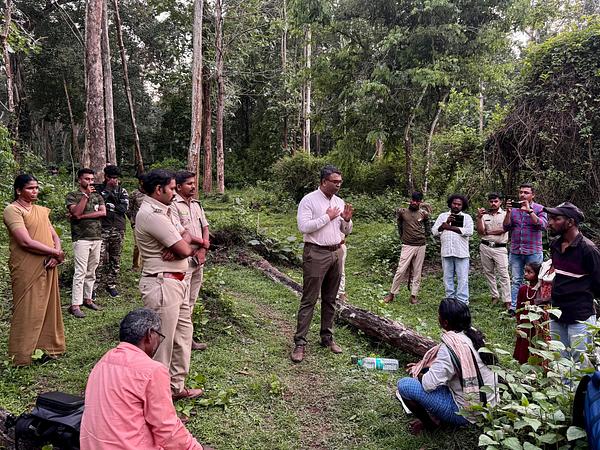
Some have begun to build houses, using their traditional materials and techniques:
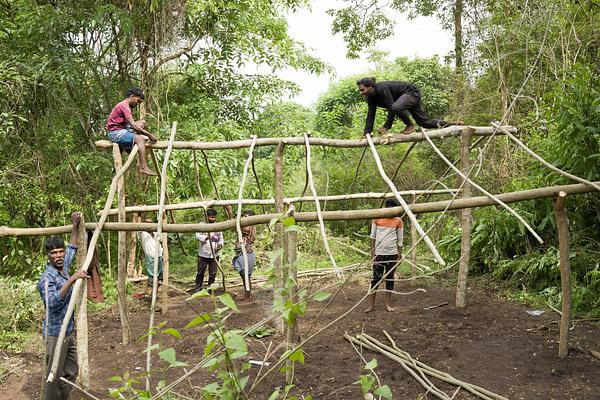
Authorities in India have illegally evicted an estimated 20,000 Jenu Kuruba people from Nagarhole. Another 6,000 resisted and have managed to stay in the park.
On Wednesday 7 May, police officers and forest guards stayed on the scene, and prevented journalists accessing the area.
The Jenu Kuruba say they decided to return because their sacred spirits, who still dwell in the old village location, became angry at being abandoned when the community was forced from the forest.
‘We resist the current conservation model’: wildlife and humans can coexist
The Jenu Kuruba of Nagarhole issued a statement:
Enough is Enough. We can’t part from our lands anymore. We want our children and youth to live a life that our ancestors once lived.
Tigers, elephants, peacocks, wild boar, wild dogs are our deities. We have been worshiping them as our ancestral spirits for generations. This deliberate attempt to separate us from our lands, forests and sacred spaces will not be tolerated. We resist the current conservation model based on the false idea that forests, wildlife and humans cannot coexist.
For decades it has been official policy in India, as in many other countries around the world, to evict Indigenous people from ancestral lands in the name of conservation. In many instances, states turn their lands are into Protected Areas, a practice known as Fortress Conservation.
The Jenu Kuruba’s belief system centers around their connection to the forest, its wildlife, and their gods. This includes the tigers who live there. However, forest guards harass, threaten, and even shoot members of the community. Those beliefs underpin the community’s careful management of their environment and have ensured tiger survival. Indeed, the healthy tiger population found in their forest is what drove the Indian government to turn the area into a Tiger Reserve. It has one of the highest concentrations of tigers in all of India.
Director of Survival International Caroline Pearce said:
The Jenu Kuruba people’s re-occupation of their ancestral land is an inspirational act of repossession. They’re reclaiming what is theirs, in defiance of a hugely powerful conservation and tourism industry that has enriched itself at their expense.
If the Indian government really cares about tiger conservation, it will not only allow the Jenu Kuruba people to return, but encourage them to do so – because the science is clear that tigers thrive alongside the Indigenous people whose forests they live in.
Images via Sartaz Ali Barkat/ Survival
By The Canary
This post was originally published on Canary.
As bombs rain down on Gaza and the world looks away, another settler colonial project is taking notes. From New Delhi to Tel Aviv, the ideological affinity between Israeli Zionism and India’s Hindutva movement has never been more pronounced as India strikes Pakistan.
And with Israel’s ongoing genocide in Gaza facing little to no meaningful international accountability, Indian Prime Minister Narendra Modi has every reason to believe that he, too, can escalate his ethno-nationalist project with impunity.
When Israel bombs a hospital, the world debates whether Hamas was hiding beneath it. When India bombs a mosque, it shrugs – wasn’t it probably a ‘terror hideout’?
The post India’s Attack On Pakistan Is Straight Out Of The Israeli Playbook appeared first on PopularResistance.Org.
This post was originally published on PopularResistance.Org.
90% of Indian workers are in the unorganized sector. This does not mean that they are outside trade union structures, but only that most workers must fight very hard to form unions. There are unions in the formal sector, of course, but there are also unions in occupations that are designed in such a way as to make unionization difficult.
For instance, rural health care workers do not work in a factory or in a shop, but across vast distances with very little contact with each other. And yet, rural health workers – or Accredited Social Health Activist (ASHA) workers, as they are called – have fought to set aside every barrier and build trade unions.
The post Workers In India Are On The March appeared first on PopularResistance.Org.
This post was originally published on PopularResistance.Org.
 Jenu Kuruba families begin their long-awaited re-occupation of their ancestral homes inside the Nagarhole National Park. They carried photos of loved ones who had died after the village was evicted, so they too can return to the forest. ©Sartaz Ali Barkat/ Survival
Jenu Kuruba families begin their long-awaited re-occupation of their ancestral homes inside the Nagarhole National Park. They carried photos of loved ones who had died after the village was evicted, so they too can return to the forest. ©Sartaz Ali Barkat/ Survival
A group of Indigenous people who were evicted from their ancestral village in Nagarhole Tiger Reserve in south India 40 years ago have returned to their former homes.
It’s believed to be the first time Indigenous people in India have asserted their rights in this way, and returned en masse to their homes after being evicted from a Protected Area.
 Forest department officials warn the Jenu Kuruba against re-occupying their homes inside Nagarhole National Park. The Indigenous people castigated them for delaying recognition of their forest rights, and went ahead anyway. ©Survival International
Forest department officials warn the Jenu Kuruba against re-occupying their homes inside Nagarhole National Park. The Indigenous people castigated them for delaying recognition of their forest rights, and went ahead anyway. ©Survival International
More than 50 Jenu Kuruba families took part in the long-planned operation, and have started building houses using their traditional materials and techniques. The Jenu Kuruba say they decided to return because their sacred spirits, who still dwell in the old village location, became angry at being abandoned when the community was forced from the forest in the 1980s.
Forest department officials, backed up by police, warned the Jenu Kuruba against re-occupying their homes, but the Indigenous people castigated them for delaying the recognition of their forest rights for years, and went ahead anyway. Today around 130 police officers and forest guards were on the scene, and prevented journalists from accessing the area.
Shivu, a young Jenu Kuruba leader, said today: “Historical injustice continues to happen over us by denying our rights on our lands, forests and access to sacred spaces. Tiger conservation is a scheme of the forest department and various wildlife NGO’s to grab indigenous lands by forcefully moving us out, but opening the very same lands in the pretext of tourism to make money
We have to today returned to our home lands and forests. we will remain here. Our sacred sprits are with us.”
 Jenu Kuruba families begin to construct a house for their ancestors, as they rebuild their old village inside Nagarhole National Park. ©Sartaz Ali Barkat/ Survival
Jenu Kuruba families begin to construct a house for their ancestors, as they rebuild their old village inside Nagarhole National Park. ©Sartaz Ali Barkat/ Survival
In a statement the Jenu Kuruba of Nagarhole said: “Enough is Enough. We can’t part from our lands anymore. We want our children and youth to live a life that our ancestors once lived. Tigers, elephants, peacocks, wild boar, wild dogs are our deities. We have been worshipping them as our ancestral spirits since generations. This deliberate attempt to separate us from our lands, forests and sacred spaces will not be tolerated. We resist the current conservation model based on the false idea that forests, wildlife and humans cannot coexist.”
For decades it has been official policy in India, as in many other countries around the world, to evict Indigenous people whose lands are turned into Protected Areas, a practice known as Fortress Conservation.
An estimated 20,000 Jenu Kuruba people have been illegally evicted from Nagarhole. Another 6,000 resisted, and have managed to stay in the park.
The Jenu Kuruba’s belief system centers around their connection to the forest, its wildlife, and their gods – including the tigers who live there – but forest guards harass, threaten, and even shoot members of the tribe.
Jenu Kuruba people are experts in their environment. They gather medicine, honey, fruits, vegetables, tubers, and the thatch and bamboo needed to build their houses.
Famed for their honey collecting skills – Jenu Kuruba means “honey collectors” – they are guided from birth to death by the philosophy “Nanga Kadu Ajjayya… Nanga Kadina Jenu Ajjayya – Our forests are sacred… The honey from our forest is sacred.”
Those beliefs underpin the tribe’s careful management of their environment and have ensured tiger survival. Indeed, the healthy tiger population found in their forest is what drove the Indian government to turn the area into a Tiger Reserve. It has one of the highest concentrations of tigers in all of India.
Caroline Pearce, Director of Survival International, said today: “The Jenu Kuruba people’s re-occupation of their ancestral land is an inspirational act of repossession. They’re reclaiming what was theirs, in defiance of a hugely powerful conservation and tourism industry that has enriched itself at their expense.
“If the Indian government really cares about tiger conservation, it will not only allow the Jenu Kuruba people to return, but encourage them to do so – because the science is clear that tigers thrive alongside the Indigenous people whose forests they live in.”
The post India: Evicted Tribe Re-occupies Their Homes inside Famous Tiger Reserve first appeared on Dissident Voice.This post was originally published on Dissident Voice.
The growing tensions between India and Pakistan reached a boiling point in the early hours of May 7 when India launched several attacks inside Pakistani territory. Eight Pakistanis were killed and 35 were injured in the “tri-service” early morning attacks by India, Director General Inter-Services Public Relations, Lieutenant General Ahmed Sharif Chaudhry, said in a press conference. Chaudhry added that one of the victims was a three-year-old girl.
The Indian Army launched the attacks as part of “Operation Sindoor” and targeted nine locations in the cities of Kotli, Muzaffarabad, and Bagh located in Pakistan-administered Kashmir, and Bahawalpur and Muridke in the Punjab province.
The post Pakistan Calls India’s Attacks ‘Unprovoked And Blatant Act Of War’ appeared first on PopularResistance.Org.
This post was originally published on PopularResistance.Org.
Dozens of people have been killed in the worst fighting between India and Pakistan in more than two decades. India attacked nine locations in Pakistan and Pakistani-controlled Kashmir early Wednesday, killing at least 26 people, including a child. Pakistan described the attacks as an act of war and responded by shelling areas controlled by India. Tensions have been soaring between the two nuclear…
This post was originally published on Latest – Truthout.
India has launched military strikes in nine areas of both Pakistan and Pakistan-administered Kashmir. The BBC reported that:
According to Pakistan, three different areas were hit: Muzaffarabad and Kotli in Pakistan-administered Kashmir, and Bahawalpur in the Pakistani province of Punjab.
Pakistani officials have said that 26 people have been killed, with 46 more injured. Al Jazeera reported that:
A Pakistani military spokesman had earlier told the broadcaster Geo that at least five locations, including two mosques, had been hit. He also said that Pakistan’s response was under way, without providing details.
In Punjab, missiles hit a mosque in the city of Bahawalpur, killing a child and wounding two civilians, the military said.
India has claimed that the strikes were targeted in areas that are part of:
terrorist infrastructure.
Israel’s genocide against Palestine has followed a remarkably similar pattern of bombing civilians while they sleep, targeting mosques, killing children, and then claiming that the whole operation was to combat terrorism.
India’s coloniality
This similarity, however, is no coincidence. Academic Hafsa Kanjwal sets out how India’s relationship to Kashmir is firmly one of settler colonialism:
When the British ruled the subcontinent, they sold Kashmir to the Dogras, Hindu chiefs from the nearby region of Jammu, in the aftermath of the first Anglo-Sikh War in 1846…Unlike most princely states, Jammu and Kashmir was one of the few where the religious identity of its ruler was different from those of the majority of its subjects. The Dogras were Hindu, while more than three-quarters of the people in the state were Muslim.
Just as Israel’s domination over Palestine has roots in British colonialism via the Balfour Declaration, so too do the contemporary politics of Kashmir originate with British and Indian coloniality. Kanjwal argues:
Kashmir is India’s colony. The exercise and expansion of Indian territorial sovereignty, especially in Kashmir, is a colonial exercise. The exercise of Indian power in Kashmir is coercive, lacks a democratic basis, denies a people self-determination, and is buttressed by an intermediary class of local elites or compradors.
However, this domination can only be understood within the context of Global North colonialism:
But it is also colonial because India’s rule in Kashmir relies on logics of more ‘classical’ forms of colonialism from Europe to the Global South: civilisational discourses, saviourism, mythologies, economic extraction and racialisation. As with all imperial or colonial forces, India has sought to rule over Kashmir through subjugating its people and trampling their rights.
Kashmiris are subject to arbitrary detention, travel bans, and broad state censorship by Indian authorities. Meenakshi Ganguly from Human Rights Watch said:
Kashmiris are unable to exercise their right to free expression, association, and peaceful assembly because they fear they will be arrested, thrown in prison without trial for months, even years.
Settler colonialism
A 2024 UN report found that a “staggering” number of Palestinians are held by Israeli authorities in Israeli detention. Just like Israel, India has also blamed a fight against terrorism as justification for structural violence against native populations.
As well as a pattern of subjugating Muslim natives whilst claiming to be fighting terrorism, India and Israel also share fascist ideologies. Hindu nationalism, or Hindutva, is in step with Zionism in a perhaps unexpected manner. Academic Vikram Visana explains, Indian prime minister Narendra Modi’s Bharatiya Janata Party (BJP) is founded on Hindutva:
Devised in the early 20th century, the politics of Hindutva insist that the country’s national identity be built around those who consider only India’s geography sacred. Muslims and Christians, whose holy sites lay in the Middle East, were therefore considered second-class citizens.
And:
Hindutva doesn’t stop at India’s borders. Hindu nationalists have used the ongoing conflict in Gaza to vilify other Muslims globally. BJP troll farms have spread disinformation and anti-Palestinian hatred online, and Hindu nationalist groups in India have organised pro-Israel marches.
In other words:
To Hindu nationalists, some Zionists were engaged in a project to reclaim their holy land from a Muslim population whose religious roots in the region were not as ancient as their own.
India: leveraging US power?
Both Hindutva and Zionist ideologies are based on purging a holy land from Muslim savages. And, it is that figure of Muslim savages that has a powerful currency in Israeli and Indian culture of Muslims as an uncontrollable, animalistic, Other. Journalist Azad Essa explains how the connecting factor for contemporary iterations of Zionist and Hindutva ideologies is a tussle for US imperialist support:
The Indian American lobby—or, more accurately, the Hindu nationalist lobby—literally modeled itself on organizations like the American Israel Public Affairs Committee (AIPAC) and the Anti-Defamation League (ADL) as they looked to replicate their methods in hustling for influence over the US government.
Essa concludes that:
Ultimately, Hindu nationalists have tried to align Indian interests with US power—and given the silence in the media and among US lawmakers about the rise of Hindutva, the occupation in Kashmir, and the attack on India’s minorities, including Muslims and Christians, I’d say they have been pretty successful.
India’s latest attacks on Pakistan and Pakistan-administered Kashmir are yet another attempt to continue the persecution of Kashmiri Muslims. Any similarities to Israel’s mode of operation in Palestine are further evidence of Hindu nationalist ideology built on Islamophobia and colonial domination. And, as with Palestine, the US’ alignment with Indian interests will likely be the difference between life and death for Kashmiris.
Featured image via the Canary
This post was originally published on Canary.
The current Kashmir crisis involves at least two nuclear powers – India and Pakistan. And it threatens to escalate quickly. But just as Israel’s oppression of people in occupied Palestine started long before 7 October 2023, India’s oppression of people in occupied Kashmir started long before 22 April this year. It’s a “forever war” with deep roots in noxious colonial rule, resource conflict, and the power games of global superpowers. And we need to understand these three points of context a lot better in order to avert nuclear disaster.
1) British colonialism set the divisive ball rolling
Much as the shameful and messy final days of British colonialism helped to bring death and destruction to Palestine, they also paved the way for a similar situation in Kashmir. Because Britain didn’t just hand Muslim-majority Kashmir to repressive Hindu rulers (without consulting the Kashmiri people) in the mid-1800s, as part of its ‘divide and rule’ policy to foster religious friction. It also allowed Kashmir’s regime, during the disastrous partition of ‘British India’, to pull the region into Indian control when it should have joined Pakistan (according to the logic of religious division). Anti-Muslim massacres and large-scale ethnic cleansing and displacement followed.
Britain was quick to leave the newly independent nations to deal with the consequences of its colonial meddling. Its implementation of partition was catastrophic (much as it was in Palestine), either by design, incompetence, disinterest, or a toxic mixture of it all. This caused immense suffering for millions of people. And it left behind a strong legacy of conflict, division, and instability. The subsequent wars between India and Pakistan, often over Kashmir, were very much the spawn of this colonial shambles.
The UN has consistently called for a plebiscite to allow Kashmiris to decide their own fate. India has rejected these calls. When resistance against Indian occupation in Kashmir increased from 1989, the occupiers responded by disappearing thousands of people and killing tens of thousands. There were also “mass permanent settlements of outsiders” in the region, and some have called the situation an “ongoing genocide“.
2) A battle for Kashmir’s water amid climate breakdown
Pakistan has an important border with China thanks to the part of Kashmir under its control. But India has something potentially even more precious within the part of Kashmir it occupies: the water that flows from the Himalayas down into (mostly) Pakistan, which is becoming less stable as a result of global warming. Back in 2016, the BBC was already talking about potential “water wars” between India and Pakistan as a result.
Natural resource wealth in Kashmir, of wood and minerals in addition to water, makes it an important asset for any government. But India in particular, home to a growing population currently standing at 1.4 billion people, has a huge water crisis. And that threatens its economic future. As the International Centre for Sustainability has said, “water is the ultimate resource war of the 21st century“.
Highly controversial Hindu-nationalist leader Narendra Modi made a big power play in this arena in 2019 when he stripped away the limited autonomy of Indian-occupied Kashmir. This was a provocative and pivotal change in the “world’s most militarized zone“, whose importance was underplayed in Western media. According to Kashmir scholars, it marked an intensification of an annexation plan that had been decades in the making.
Serious abuses followed as Modi sought to consolidate the land grab. These included “unlawful killings“, gender-based violence, attempts at cultural erasure, the arming of Hindu militias, “Indian soldiers prominent on the streets 24/7“, and “house raids and arbitrary arrest” of dissenting voices. Despite being a warzone and site of intense repression, though, the Indian regime pushed tourism in the area too.
3) The global neoliberal-nationalist alliance
India initially remained independent (but left-leaning) during the Cold War and stood alongside anti-colonial movements around the world. Pakistan, on the other hand, fell quickly into the US anti-communist camp, with its autocratic regimes receiving significant military aid as a result. This lucrative alliance severely undermined secular progressives and empowered ultra-conservative elements in the country, helping Pakistan to build nuclear weapons. The reality the US had fostered eventually led to increasing tensions between Pakistan and Washington in the early 21st-century, pushing Pakistan closer to China as a result.
India, meanwhile, became more attractive to the US as it moved towards neoliberalism in the 1990s. And under Narendra Modi, this has only intensified, alongside increasing inequality, “nutritional deprivation”, and authoritarianism to hold dissent at bay.
With Donald Trump in particular intensifying a new cold war with China and India having its own issues with China, an increasing US-Indian strategic alliance is in the making (helped by a toxic neoliberal-nationalist affinity). And ignoring the crimes of India’s occupation forces in Kashmir is part and parcel of such an alliance, much as US support for Israeli occupation forces is in Palestine.
In Britain, meanwhile, establishment tool Keir Starmer overturned his predecessor’s solidarity with Kashmir when he became leader of the Labour Party, quickly cosying up to Modi’s regime.
Without justice, there will be no peace in Kashmir
As tensions rise between the nuclear powers in South Asia, it’s clear that, even if India and Pakistan avoid war, a lasting peace will not come without: meaningfully addressing the decades of injustice in Kashmir; fostering respectful diplomacy that can help to deal with the challenges increasingly presented by climate destruction; and working to overcome the deeply engrained ethno-religious division nurtured by British colonialism. Western powers taking the side of another ultra-nationalist occupying power, out of cynical self-interest, will only make matters worse.
Featured image via the Canary
By Ed Sykes
This post was originally published on Canary.
The Indian Ministry of Defence (MoD) has signed an agreement with the French government to acquire 26 Dassault Rafale fighter aircraft worth US$7.4 billion for the Indian Navy. The Intergovernmental agreement (IGA) signed on 28 April provisions for 22 Rafale M single-seat and four twin-seat Rafale trainer aircraft, the Indian Ministry of Defence (MoD) said. […]
The post India signs for naval Dassault Rafale aircraft appeared first on Asian Military Review.
This post was originally published on Asian Military Review.
India’s Hindutva president, Narendra Modi, has used the Kashmir terrorism incident to abrogate the 1960s Indus Waters Treaty — a longstanding goal of Modi. The Indian version of the “terrorist attack,” most of whose victims were Muslim, has largely been accepted by Western governments without evidence.
False flags abound nowadays. You may recall that we were told that the most deadly rocket ever fired by Hamas killed only Palestinians in a hospital compound, while the most deadly rocket ever fired by Hezbollah killed only Druze children. I have at present an open mind about what occurred in Kashmir.
The post Kashmir And The Indus River appeared first on PopularResistance.Org.
This post was originally published on PopularResistance.Org.
In a region already on the brink, the latest violence in Indian-occupied Kashmir has intensified a decades-old conflict between nuclear-armed India and Pakistan. The attack, which targeted Indian tourists in the Pahalgam valley, killing 26, has quickly escalated into a diplomatic and military standoff.
With India and Pakistan trading accusations and retaliatory measures, the potential for full-scale conflict is growing – especially as external players like the US and Israel loom over the situation, each with their own interests in fueling or containing the crisis.
A web of conspiracy and suspicion has surrounded the incident in Kashmir, with missing links complicating the narrative.
The post India–Pakistan Standoff: Who Is Fanning Nuclear Flames? appeared first on PopularResistance.Org.
This post was originally published on PopularResistance.Org.
Authorities have barred a Vietnamese Buddhist monk from continuing a barefoot pilgrimage through Sri Lanka so he’s departing instead for his final destination, India, a source told Radio Free Asia.
Thich Minh Tue, who departed on a multi-nation journey from Vietnam four months ago, was stopped in his tracks by Sri Lankan police last week who cited a letter from Vietnam’s state-sanctioned Buddhist sangha – or Buddhist religious association – describing him as posing a threat to public order.
His group, which also includes 10 volunteers, has since been provided temporary accommodation at a temple. They were given permission only to meet and receive food from visitors and well-wishers outside the temple, northeast of the capital Colombo, but were barred from continuing their hike, the source, who requested anonymity to discuss the sensitive issue, told RFA.
When it became clear that the group would not be allowed to continue their walk in Sri Lanka, the group decided to immediately leave for India instead, he said.
“They don’t give us a green light to resume walking … on the road,” said Phuoc Nghiem, a close associate of Thich Minh Tue, during a YouTube livestream on Wednesday.
The source said Thich Minh Tue is expected to arrive in India’s capital New Delhi by flight from Sri Lanka at around 5:00 a.m. on Friday. From there, he is expected to fly to Bodh Gaya, the place where Buddha attained enlightenment, and will continue his walk there.

Thich Minh Tue became an unlikely internet sensation last year in Vietnam where his simple lifestyle has struck a chord. He undertook barefoot walks that went viral and well-wishers came out in droves. But authorities treat him with some suspicion as he is not officially recognized as a monk.
Last December, he set out from his homeland on what was meant to be a 2,700-kilometer (1,600 mile) journey by foot through several Asian nations.
Since leaving Vietnam, he and his companions have traveled through Laos and Thailand, and then took a detour to Malaysia after he ran into problems trying to enter Myanmar. He had intended to cross that war-torn country to get to India. After Malaysia he went to Sri Lanka and had intended to walk to the north of the South Asian nation and take a ferry to India.
A copy of the letter from a representative of the Vietnamese sangha that was cited by Sri Lankan police has been viewed by RFA. It accuses Thich Minh Tue of impersonating a Buddhist monk, attempting to establish a dissident sect, and posing threat to public order and national reputation.
Edited by Tenzin Pema and Mat Pennington.
This content originally appeared on Radio Free Asia and was authored by RFA Vietnamese.
This post was originally published on Radio Free.
Authorities have barred a Vietnamese Buddhist monk from continuing a barefoot pilgrimage through Sri Lanka so he’s departing instead for his final destination, India, a source told Radio Free Asia.
Thich Minh Tue, who departed on a multi-nation journey from Vietnam four months ago, was stopped in his tracks by Sri Lankan police last week who cited a letter from Vietnam’s state-sanctioned Buddhist sangha – or Buddhist religious association – describing him as posing a threat to public order.
His group, which also includes 10 volunteers, has since been provided temporary accommodation at a temple. They were given permission only to meet and receive food from visitors and well-wishers outside the temple, northeast of the capital Colombo, but were barred from continuing their hike, the source, who requested anonymity to discuss the sensitive issue, told RFA.
When it became clear that the group would not be allowed to continue their walk in Sri Lanka, the group decided to immediately leave for India instead, he said.
“They don’t give us a green light to resume walking … on the road,” said Phuoc Nghiem, a close associate of Thich Minh Tue, during a YouTube livestream on Wednesday.
The source said Thich Minh Tue is expected to arrive in India’s capital New Delhi by flight from Sri Lanka at around 5:00 a.m. on Friday. From there, he is expected to fly to Bodh Gaya, the place where Buddha attained enlightenment, and will continue his walk there.

Thich Minh Tue became an unlikely internet sensation last year in Vietnam where his simple lifestyle has struck a chord. He undertook barefoot walks that went viral and well-wishers came out in droves. But authorities treat him with some suspicion as he is not officially recognized as a monk.
Last December, he set out from his homeland on what was meant to be a 2,700-kilometer (1,600 mile) journey by foot through several Asian nations.
Since leaving Vietnam, he and his companions have traveled through Laos and Thailand, and then took a detour to Malaysia after he ran into problems trying to enter Myanmar. He had intended to cross that war-torn country to get to India. After Malaysia he went to Sri Lanka and had intended to walk to the north of the South Asian nation and take a ferry to India.
A copy of the letter from a representative of the Vietnamese sangha that was cited by Sri Lankan police has been viewed by RFA. It accuses Thich Minh Tue of impersonating a Buddhist monk, attempting to establish a dissident sect, and posing threat to public order and national reputation.
Edited by Tenzin Pema and Mat Pennington.
This content originally appeared on Radio Free Asia and was authored by RFA Vietnamese.
This post was originally published on Radio Free.
On March 28, 2025, pro-republic and pro-monarchy forces organised rival protests in Nepal’s capital, Kathmandu, to showcase public support for and against the Republic. According to the Ministry of Home Affairs, about 4,000 people attended the pro-monarchy rally, while around 35,000 joined the pro-republican protest. This was the second major monarchist demonstration following a bigger rally welcoming the king back from Pokhara on March 9. Pro-monarchy forces have been increasingly active, particularly after the former king Gyanendra Shah’s provocative statement on the eve of Democracy Day (February 19).
Sensing the offense of counterrevolutionary forces, the pro-republican protest, organized under the Socialist Front, an alliance of the four opposition left parties, aimed to counter what they call reactionary and regressive forces. While the republican demonstration remained peaceful, the monarchists turned violent, vandalizing public and private property and attacking security personnel. In the aftermath, two people lost their lives, and several were injured.
The violent pro-monarchy demonstration sparked intense debate. Republicans claim the monarchists attempted to create chaos and exploit the crisis while the government also accused them of inciting violence. The monarchists, however, argue they faced suppression from the police.
![]()
Pro-monarchy protestors turn violent in Tinkune and Kathmandu. Source: Online People’s News
Recognising the impact of March 28 protests, inside and outside Nepal, the monarchists are planning nationwide protests and have already formed a joint coordination committee. Meanwhile, after the monarchists vandalised the Communist Party of Nepal (Unified Socialist) [CPN (US)] headquarters and damaged properties, the Socialist Front has committed to defend the achievements of the peaceful People’s Movement of 2006, which abolished monarchy and paved the way for a socialism-oriented constitution. Uncertainty remains, but two things are evident: Monarchists are uniting and mobilising aggressively, while republican forces remain firm. This could strengthen left unity, though questions persist about division within the largest parties, the Communist Party of Nepal (Unified Marxist–Leninist) [CPN (UML)]) and Nepali Congress (NC) on republicanism.
NC leader Sher Bahadur Deuba may support the Republic, but it is an open secret that many others within his party favour Hindu nationalism and monarchy, and oppose the federal structure of Nepal. There many who question the ruling CPN (UML) asking if its top leadership is pro-monarchy, even while acknowledging that majority oppose the monarchy within the party. The fourth-largest party, the independent Rastriya Swatantra Party (RSP), and Kathmandu’s mayor, rapper Balen Shah, are exploiting the situation to challenge traditional parties and the current political system. There are reports that the monarchists are backed by Indian forces – the ruling regime, the Rastriya Swayamsevak Sangh’s (RSS) active role in Nepal, and the Uttar Pradesh Chief Minister Yogi Adityanath – who are supporting financially, politically, and even militarily. The republicans struggle in Nepal for defending constitutional democracy will not be that easy.
![]()
Mekha Limbu(Nepal), We are on the way to death, 2012.
Historical Context and Dialectics
Nepal’s unpredictable politics cannot be understood without historical, dialectical, and global perspectives. Its geopolitical location, India-China rivalry, Hindu fundamentalism, US influence, and EU interests, the recent populist tendencies, etc. have turned Nepal into a battleground for power struggles. When leftist coalitions emerge to govern the country India in alliance with the US and right-wing forces, works to weaken them. Internal party rifts further destabilize the government. Therefore, it may be seen that all the forces within the nation and outside, will unite to weaken Nepali state and create further crisis.
Political instability has been a great challenge of Nepalese democracy. Nepal’s political instability is evident in its frequent government changes – 32 since multiparty democracy was restored in 1990, and 13 since Nepal became a republic in 2008. The current government that ruling Nepal is the 14th.
On top political instability, the republicans in Nepal underestimated the monarchy’s revival. Even leftist forces overlooked the resurgence of counterrevolutionary elements. Some self-proclaimed theoreticians focused solely on comprador bourgeoisie as the enemy of Nepal’s working class while ignoring conservatives, reactionaries, and fundamentalists. As previously noted, after overthrowing the monarchy, there was no significant effort to transform production relations in Nepal and create alternative cultural structures, leaving ample space for people to aspire for the monarchy’s return.
Mass media and social media blame top leaders Deuba, K. P. Sharma Oli, and Prachanda, who have collectively ruled for decades, for the crises. Deuba has been prime minister six times, Oli four, and Prachanda three. Other former PMs still lead parties and remain active. These aging leaders have dominated Nepal’s politics for 30 years. However, deeper systemic issues are more influential than people or parties.
![]()
Socialist Front rallies at Bhrikuti Mandap. Source: Online People’s News
Why Is This Happening in Nepal?
A.) Political Instability and Systemic Crisis
Nepal faces severe political instability, deep inequality, unemployment, slow economic growth, weak industrialisation, mass migration, poverty, food insecurity, and rising debt. Climate crises and disasters add to these challenges. Various forces exploit these crises for their interests. Government changes bring only new rulers, not solutions. People are increasingly frustrated with political parties and the system itself. The 2015 Constitution of Nepal, which established a federal democratic republic, is under threat. Federalism is criticised, republicanism is questioned, and neo-fascism and populism are on the rise. Pro-monarchist forces are capitalising on this turmoil. While most acknowledge Nepal’s problems, reactionary forces blame political parties and the republican system itself. They falsely claim that restoring monarchy, re-establishing a Hindu state, and ending federalism as the solutions. It is prudent to note that many of these groups receive political and financial support from Hindutva-aligned conservatives.
B.) Failure of the Government to Deliver
The current government holds a two-thirds majority, with two parties who have been historically rivals uniting. Its failure to govern effectively is seen as proof that Nepal’s political system itself is failing. This perception fuels calls for alternative governance models, including a return to monarchy.
C.) Corruption, Bad Governance, and Impunity
Recent scandals—such as the Gold Scam, Bhutanese Refugee Scam, and Giri Bandhu Tea Estate Scam—have exposed massive corruption within the state. People now believe that no political leader is clean, as all have been in power at some point. Lack of rule of law, poor governance, and impunity for corrupt leaders have enraged the public. The perception that all top leaders are involved in scandals has made accountability almost impossible.
D.) Public Frustration and Growing Anti-Establishment Sentiment
Government failure, rising unemployment, and foreign labour migration have fuelled widespread frustration. Reactionary and populist forces frame their movements as a revolt against the political establishment. This anti-establishment sentiment explains the rise of figures like Durga Prasai and Kathmandu Mayor Balen Shah. Shah’s election was largely due to public anger toward traditional parties. People are increasingly rejecting established political structures, creating space for monarchists and other challengers.
![]()
Shashi Bikram Shah(Nepal), Royal Massacre Series, 2001.
E.) Lack of Development Agendas and Weak Leadership
Nepali leaders lack a vision for national development. They show little concern for public suffering, employment opportunities, or economic growth. Instead, they are focused on power, corruption, and alliances with corporate and comprador elites. Leadership incompetence is another major issue. Most leaders have failed to demonstrate effective governance. Though they may be politically experienced, they lack the ability to transform Nepal’s economy and society.
F.) Weakening of the State and Attacks on the Left
There is lot of ideological degeneration in Nepal’s Left movements as they are heavily infiltrated by conservatives. Also, political revisionism has made the Left on the whole indistinguishable from the bourgeois parties. Many leftists have abandoned class struggle, allowing right-wing forces to gain ground. Anti-communist elements are actively working to defame Nepal’s left, weakening national sovereignty and progress. A corrupt judiciary and penetrated bureaucracy further ensure that genuine reformers are isolated or sidelined. Crime networks and muscle power dominate the political scene, making systemic change difficult.
Amid this crisis, pro-monarchy conservatives and reactionaries are exploiting public frustration. While systemic failures are widely acknowledged, these groups falsely present monarchy, Hindu nationalism, and the abolition of federalism as solutions. Many suspect these efforts are backed by right-wing Hindutva groups.
Major political parties’ failure to offer a development agenda has left a vacuum that reactionary forces are filling. The 2015 Constitution, which established Nepal as a federal democratic republic, now faces threats from both political actors and street movements. Federalism is under scrutiny, republicanism is questioned, and neo-fascist and populist movements are growing.
Urgent responses from the government and political parties are necessary. Nepal’s crisis is deeply systemic, with instability and foreign interference fuelling continued failure. Without addressing corruption, delivering reforms, and safeguarding democratic institutions, Nepal risks further regression. The world watches as one of the youngest republics struggles to navigate this precarious moment.
The post Challenges to Nepal’s Republican Structure from Monarchists and Why? first appeared on Dissident Voice.
On March 28, 2025, pro-republic and pro-monarchy forces organised rival protests in Nepal’s capital, Kathmandu, to showcase public support for and against the Republic. According to the Ministry of Home Affairs, about 4,000 people attended the pro-monarchy rally, while around 35,000 joined the pro-republican protest. This was the second major monarchist demonstration following a bigger rally welcoming the king back from Pokhara on March 9. Pro-monarchy forces have been increasingly active, particularly after the former king Gyanendra Shah’s provocative statement on the eve of Democracy Day (February 19).
Sensing the offense of counterrevolutionary forces, the pro-republican protest, organized under the Socialist Front, an alliance of the four opposition left parties, aimed to counter what they call reactionary and regressive forces. While the republican demonstration remained peaceful, the monarchists turned violent, vandalizing public and private property and attacking security personnel. In the aftermath, two people lost their lives, and several were injured.
The violent pro-monarchy demonstration sparked intense debate. Republicans claim the monarchists attempted to create chaos and exploit the crisis while the government also accused them of inciting violence. The monarchists, however, argue they faced suppression from the police.
![]()
Pro-monarchy protestors turn violent in Tinkune and Kathmandu. Source: Online People’s News
Recognising the impact of March 28 protests, inside and outside Nepal, the monarchists are planning nationwide protests and have already formed a joint coordination committee. Meanwhile, after the monarchists vandalised the Communist Party of Nepal (Unified Socialist) [CPN (US)] headquarters and damaged properties, the Socialist Front has committed to defend the achievements of the peaceful People’s Movement of 2006, which abolished monarchy and paved the way for a socialism-oriented constitution. Uncertainty remains, but two things are evident: Monarchists are uniting and mobilising aggressively, while republican forces remain firm. This could strengthen left unity, though questions persist about division within the largest parties, the Communist Party of Nepal (Unified Marxist–Leninist) [CPN (UML)]) and Nepali Congress (NC) on republicanism.
NC leader Sher Bahadur Deuba may support the Republic, but it is an open secret that many others within his party favour Hindu nationalism and monarchy, and oppose the federal structure of Nepal. There many who question the ruling CPN (UML) asking if its top leadership is pro-monarchy, even while acknowledging that majority oppose the monarchy within the party. The fourth-largest party, the independent Rastriya Swatantra Party (RSP), and Kathmandu’s mayor, rapper Balen Shah, are exploiting the situation to challenge traditional parties and the current political system. There are reports that the monarchists are backed by Indian forces – the ruling regime, the Rastriya Swayamsevak Sangh’s (RSS) active role in Nepal, and the Uttar Pradesh Chief Minister Yogi Adityanath – who are supporting financially, politically, and even militarily. The republicans struggle in Nepal for defending constitutional democracy will not be that easy.
![]()
Mekha Limbu(Nepal), We are on the way to death, 2012.
Historical Context and Dialectics
Nepal’s unpredictable politics cannot be understood without historical, dialectical, and global perspectives. Its geopolitical location, India-China rivalry, Hindu fundamentalism, US influence, and EU interests, the recent populist tendencies, etc. have turned Nepal into a battleground for power struggles. When leftist coalitions emerge to govern the country India in alliance with the US and right-wing forces, works to weaken them. Internal party rifts further destabilize the government. Therefore, it may be seen that all the forces within the nation and outside, will unite to weaken Nepali state and create further crisis.
Political instability has been a great challenge of Nepalese democracy. Nepal’s political instability is evident in its frequent government changes – 32 since multiparty democracy was restored in 1990, and 13 since Nepal became a republic in 2008. The current government that ruling Nepal is the 14th.
On top political instability, the republicans in Nepal underestimated the monarchy’s revival. Even leftist forces overlooked the resurgence of counterrevolutionary elements. Some self-proclaimed theoreticians focused solely on comprador bourgeoisie as the enemy of Nepal’s working class while ignoring conservatives, reactionaries, and fundamentalists. As previously noted, after overthrowing the monarchy, there was no significant effort to transform production relations in Nepal and create alternative cultural structures, leaving ample space for people to aspire for the monarchy’s return.
Mass media and social media blame top leaders Deuba, K. P. Sharma Oli, and Prachanda, who have collectively ruled for decades, for the crises. Deuba has been prime minister six times, Oli four, and Prachanda three. Other former PMs still lead parties and remain active. These aging leaders have dominated Nepal’s politics for 30 years. However, deeper systemic issues are more influential than people or parties.
![]()
Socialist Front rallies at Bhrikuti Mandap. Source: Online People’s News
Why Is This Happening in Nepal?
A.) Political Instability and Systemic Crisis
Nepal faces severe political instability, deep inequality, unemployment, slow economic growth, weak industrialisation, mass migration, poverty, food insecurity, and rising debt. Climate crises and disasters add to these challenges. Various forces exploit these crises for their interests. Government changes bring only new rulers, not solutions. People are increasingly frustrated with political parties and the system itself. The 2015 Constitution of Nepal, which established a federal democratic republic, is under threat. Federalism is criticised, republicanism is questioned, and neo-fascism and populism are on the rise. Pro-monarchist forces are capitalising on this turmoil. While most acknowledge Nepal’s problems, reactionary forces blame political parties and the republican system itself. They falsely claim that restoring monarchy, re-establishing a Hindu state, and ending federalism as the solutions. It is prudent to note that many of these groups receive political and financial support from Hindutva-aligned conservatives.
B.) Failure of the Government to Deliver
The current government holds a two-thirds majority, with two parties who have been historically rivals uniting. Its failure to govern effectively is seen as proof that Nepal’s political system itself is failing. This perception fuels calls for alternative governance models, including a return to monarchy.
C.) Corruption, Bad Governance, and Impunity
Recent scandals—such as the Gold Scam, Bhutanese Refugee Scam, and Giri Bandhu Tea Estate Scam—have exposed massive corruption within the state. People now believe that no political leader is clean, as all have been in power at some point. Lack of rule of law, poor governance, and impunity for corrupt leaders have enraged the public. The perception that all top leaders are involved in scandals has made accountability almost impossible.
D.) Public Frustration and Growing Anti-Establishment Sentiment
Government failure, rising unemployment, and foreign labour migration have fuelled widespread frustration. Reactionary and populist forces frame their movements as a revolt against the political establishment. This anti-establishment sentiment explains the rise of figures like Durga Prasai and Kathmandu Mayor Balen Shah. Shah’s election was largely due to public anger toward traditional parties. People are increasingly rejecting established political structures, creating space for monarchists and other challengers.
![]()
Shashi Bikram Shah(Nepal), Royal Massacre Series, 2001.
E.) Lack of Development Agendas and Weak Leadership
Nepali leaders lack a vision for national development. They show little concern for public suffering, employment opportunities, or economic growth. Instead, they are focused on power, corruption, and alliances with corporate and comprador elites. Leadership incompetence is another major issue. Most leaders have failed to demonstrate effective governance. Though they may be politically experienced, they lack the ability to transform Nepal’s economy and society.
F.) Weakening of the State and Attacks on the Left
There is lot of ideological degeneration in Nepal’s Left movements as they are heavily infiltrated by conservatives. Also, political revisionism has made the Left on the whole indistinguishable from the bourgeois parties. Many leftists have abandoned class struggle, allowing right-wing forces to gain ground. Anti-communist elements are actively working to defame Nepal’s left, weakening national sovereignty and progress. A corrupt judiciary and penetrated bureaucracy further ensure that genuine reformers are isolated or sidelined. Crime networks and muscle power dominate the political scene, making systemic change difficult.
Amid this crisis, pro-monarchy conservatives and reactionaries are exploiting public frustration. While systemic failures are widely acknowledged, these groups falsely present monarchy, Hindu nationalism, and the abolition of federalism as solutions. Many suspect these efforts are backed by right-wing Hindutva groups.
Major political parties’ failure to offer a development agenda has left a vacuum that reactionary forces are filling. The 2015 Constitution, which established Nepal as a federal democratic republic, now faces threats from both political actors and street movements. Federalism is under scrutiny, republicanism is questioned, and neo-fascist and populist movements are growing.
Urgent responses from the government and political parties are necessary. Nepal’s crisis is deeply systemic, with instability and foreign interference fuelling continued failure. Without addressing corruption, delivering reforms, and safeguarding democratic institutions, Nepal risks further regression. The world watches as one of the youngest republics struggles to navigate this precarious moment.
This post was originally published on Dissident Voice.
A claim emerged in Chinese-language social media posts that a U.S. congressman named “Jack Kimble” suggested selling all American beef to India if China stops importing it.
But the claim is false. There is no U.S. congressman by that name. The claim originated from a satirical social media post.
A Taiwanese political talk show, TVBS News Talk, cited Chinese outlet NetEase to claim that a U.S. congressman named “Jack Kimble” suggested selling all American beef to India if China stops importing it.
The guest of the show, retired Taiwanese Lt. Gen. Shuai Hua-min, used the claim to criticize the U.S. as ignorant, noting that Indians don’t eat beef.
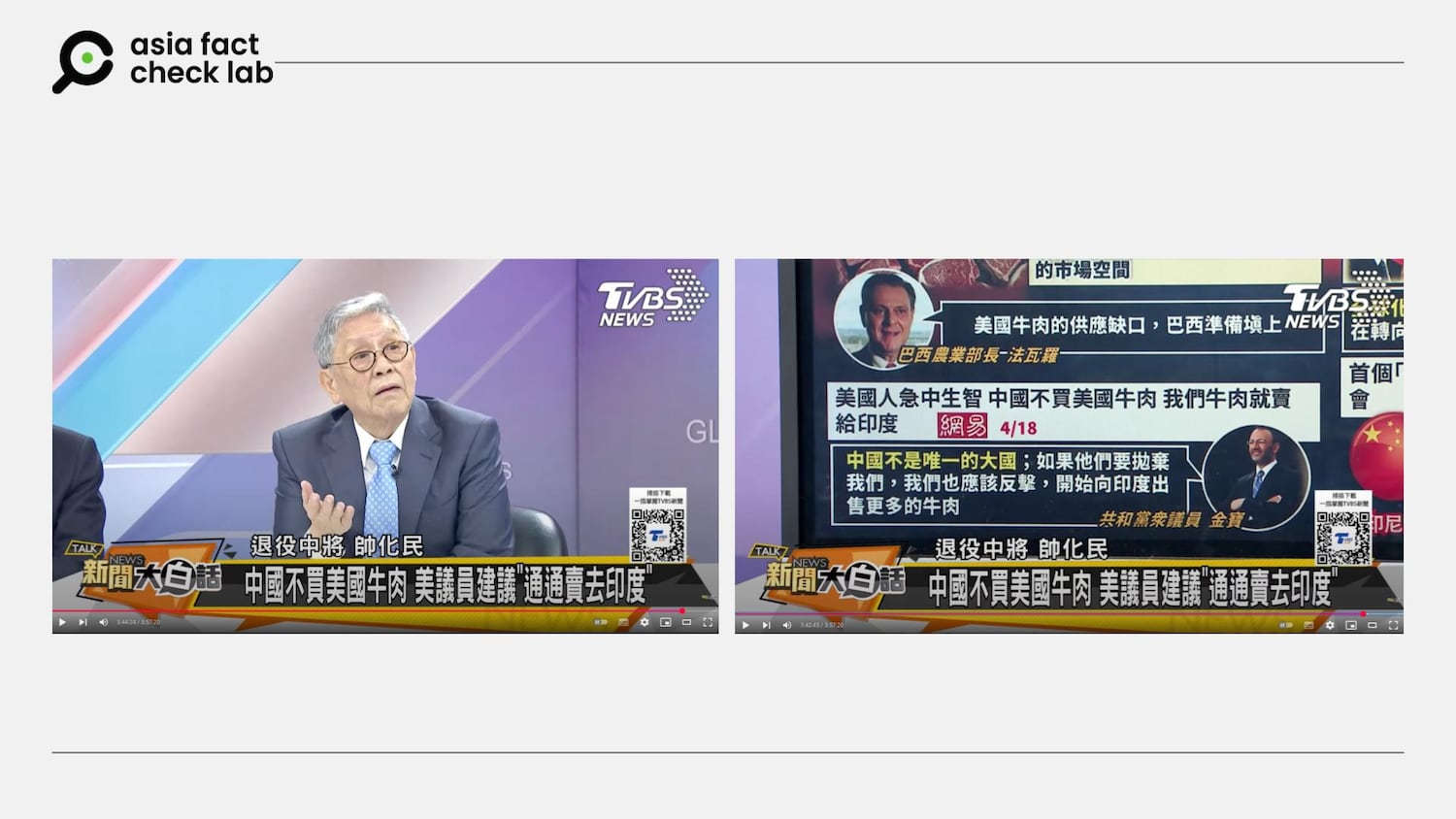
The U.S. and China are waging a tit-for-tat trade battle, which threatens to stunt the global economy, after Trump announced new tariffs on most countries.
Specifically, the Trump administration has ramped up its trade war with Beijing by hiking import taxes on Chinese goods to as high as 145%
China, which has pledged to “fight to the end” if Washington continues to escalate the trade spat, has hit back by imposing duties of 125% on U.S. exports, prompting U.S. companies to seek alternative markets and manufacturing bases.
India has emerged as a key partner in this realignment. U.S. Vice President JD Vance recently visited India to advance negotiations on a bilateral trade deal aimed at boosting trade from the current US$190 billion to US$500 billion by 2030. Discussions include tariff relief and increased imports of U.S. goods by India .
But the claim about the purported remarks made by a U.S. congressman named “Jack Kimble” is false.
Keyword searches found that the claim originated from a satirical post from a parody X account named “Rep. Jack Kimble.”
The account is known for political satire and explicitly describes itself as representing California’s fictional 54th congressional district – California only has 52 districts.
According to the official website of the U.S. House of Representatives, there is no member named “Jack Kimble.”
On April 16, the parody account posted a satirical message suggesting selling beef to India if China stops buying it. This post was mistakenly translated and widely shared across Chinese social media platforms, including Weibo, Douyin, and even Chinese state-affiliated outlets like Hua Shang Daily.

Other claims made by the satirical X account have been debunked by Reuters, USA Today, and PolitiFact.
Edited by Taejun Kang.
Asia Fact Check Lab (AFCL) was established to counter disinformation in today’s complex media environment. We publish fact-checks, media-watches and in-depth reports that aim to sharpen and deepen our readers’ understanding of current affairs and public issues. If you like our content, you can also follow us on Facebook, Instagram and X.
This content originally appeared on Radio Free Asia and was authored by Alicia Dong for Asia Fact Check Lab.
Writing in his cell as a political prisoner in fascist Italy after World War I, the philosopher Antonio Gramsci famously declared: “The crisis consists precisely in the fact that the old is dying and the new cannot be born; in this interregnum a great variety of morbid symptoms appear.”
A century later, we are in another interregnum, and the morbid symptoms are everywhere. The U.S.-led order has ended, but the multipolar world is not yet born. The urgent priority is to give birth to a new multilateral order that can keep the peace and the path to sustainable development.
We are at the end of a long wave of human history that commenced with the voyages of Christopher Columbus and Vasco da Gama more than 500 years ago.
The post Birthing A New International Order appeared first on PopularResistance.Org.
This post was originally published on PopularResistance.Org.
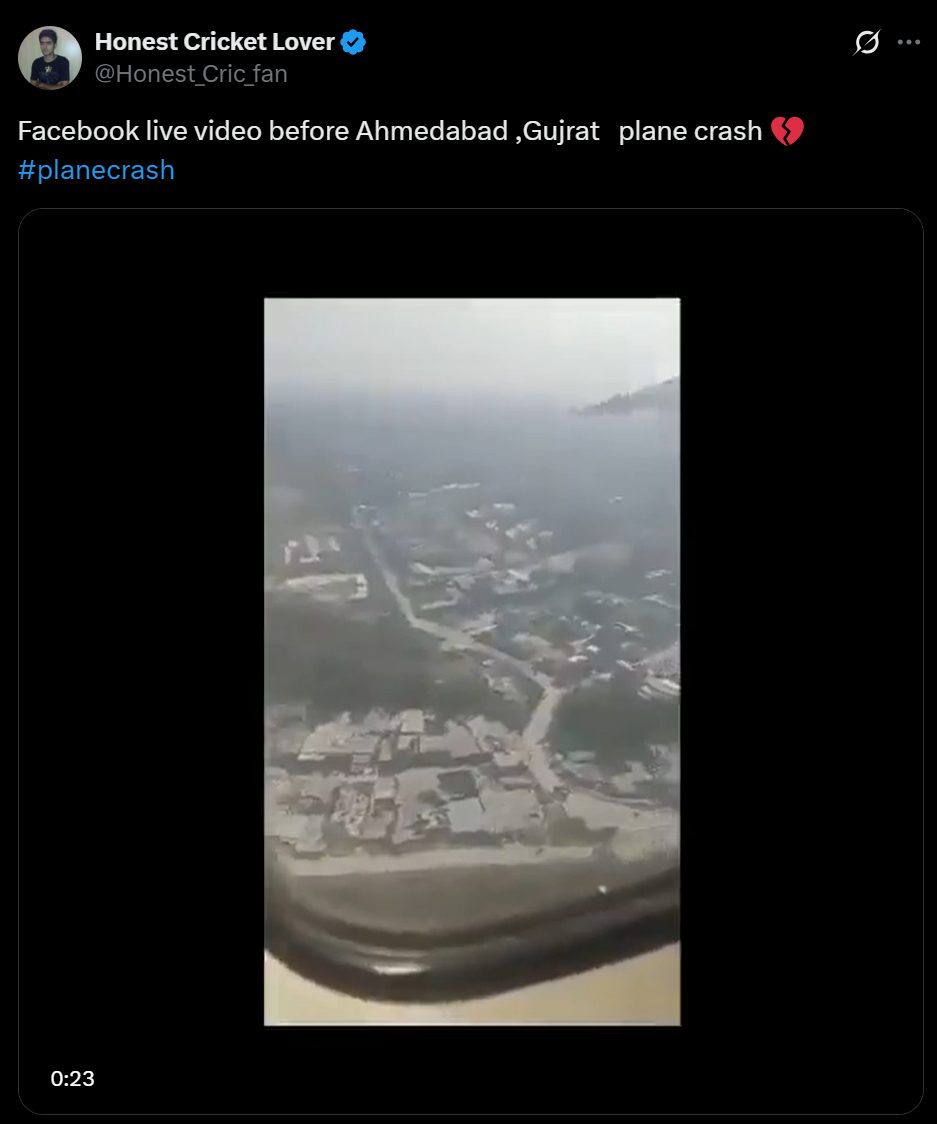

 वीडियो नेपाल में जनवरी 2023 में हुए विमान हादसे की है।
वीडियो नेपाल में जनवरी 2023 में हुए विमान हादसे की है।
